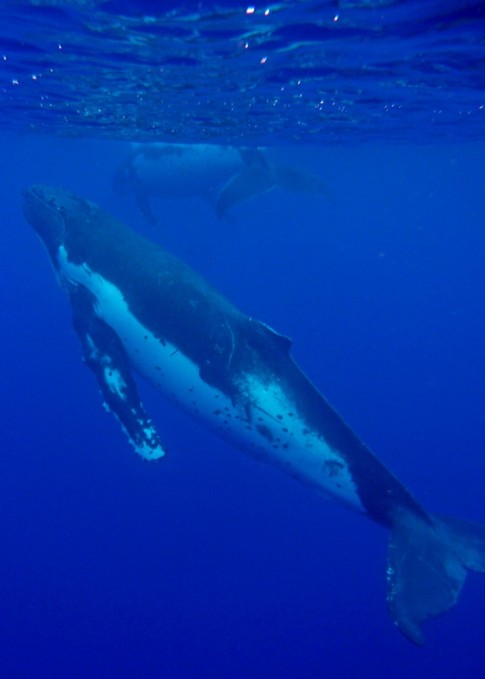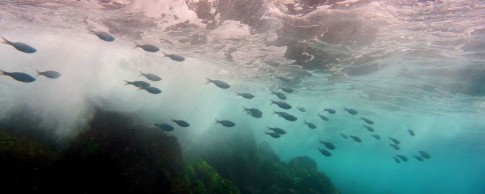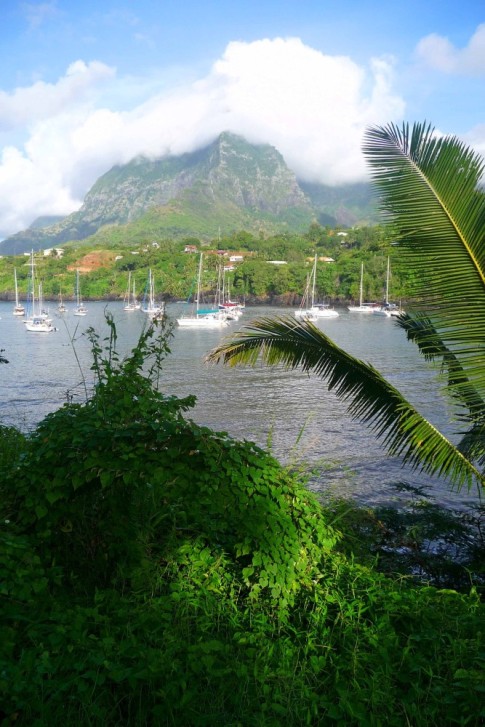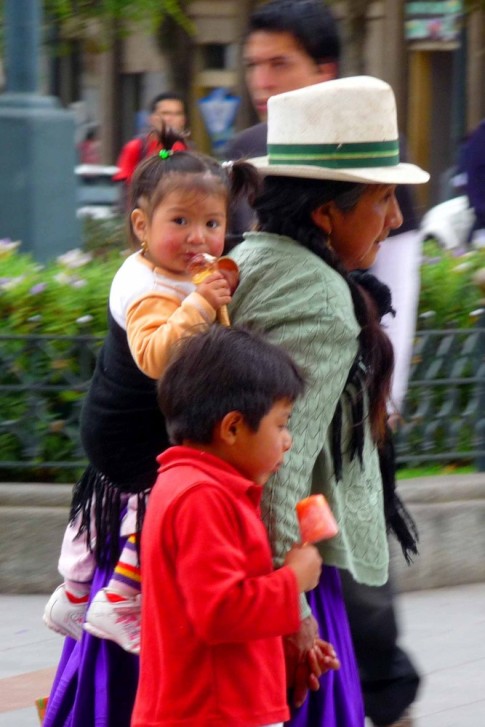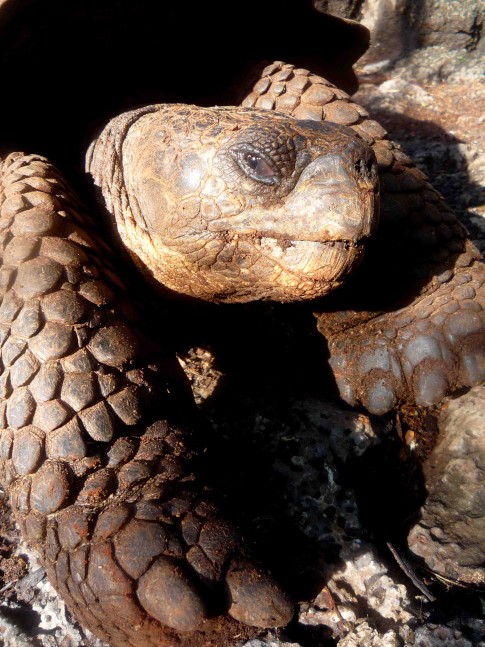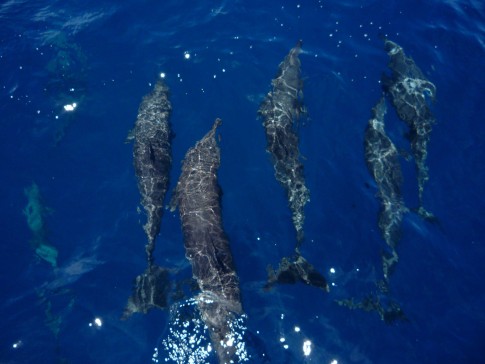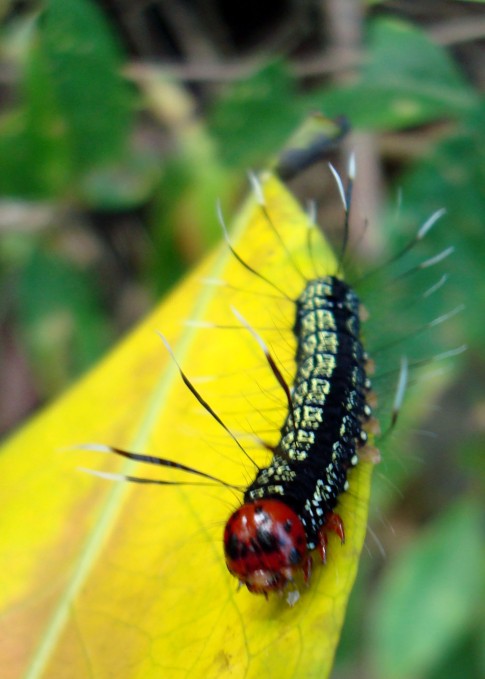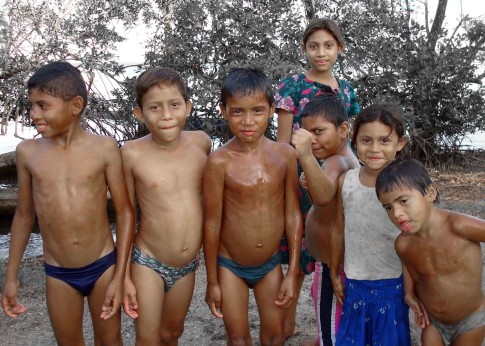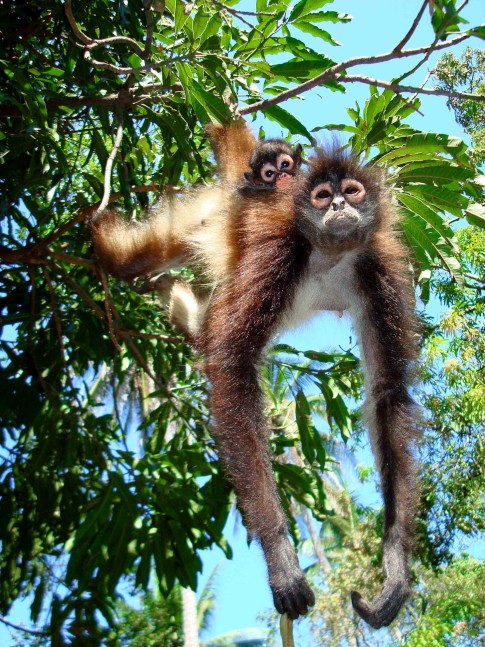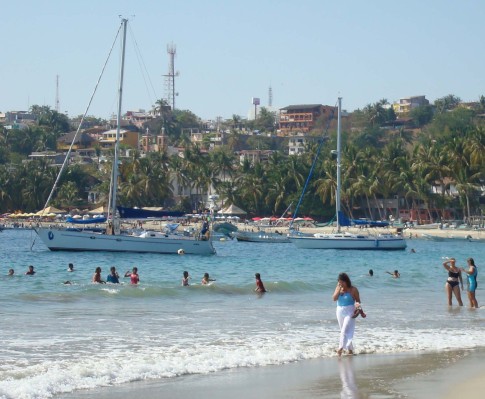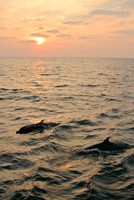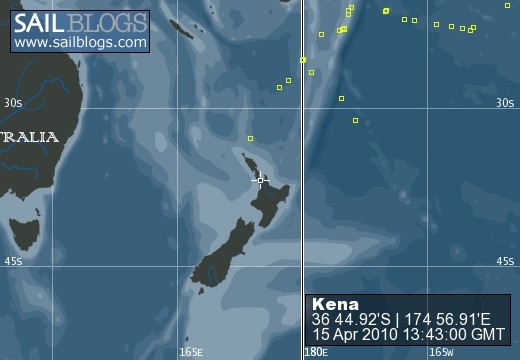
Kena
22 November 2009 | Tutukaka
11 November 2009
10 November 2009
09 November 2009
07 November 2009
07 November 2009
04 November 2009
03 November 2009
01 October 2009
29 September 2009
05 September 2009 | Nuku'alofa
27 August 2009
27 August 2009
23 August 2009
16 August 2009
14 August 2009
12 August 2009
09 August 2009
08 August 2009
08 August 2009
First Days at Cocos
29 March 2008
Roger
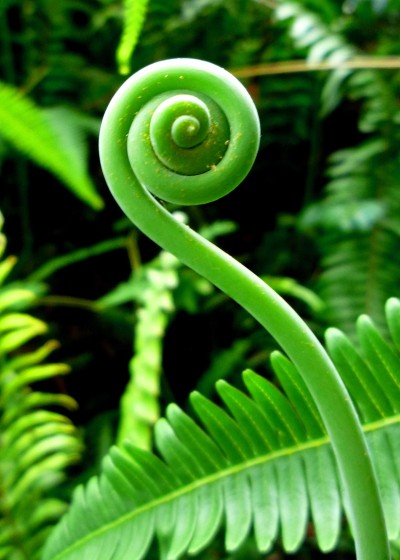
We awoke to the sight of cliffs and steep hills totally covered in greenery. Around the bay, waterfalls tumble directly into the sea. Shortly after dawn, all of the boats save us and a catamaran moored near the smaller Isla Manuelita cast off and headed around the point. We learned later that they'd all gone round to Bahia Wafer for the day's diving.
We're in 50 feet of water and the bottom is clearly visible. There is a crowd of large fish cruising around underneath Kena. There's blue jacks, surgeon fish and a number of others we haven't yet identified. They're much larger than any we've had around the boat before, no doubt because all fishing is banned out to the 12 mile limit. We found a dead flying fish on the deck and tossed it over whole. It drifted for a while until it was noticed and consumed in one slashing run.
Tane, who is a master a sleeping in, got up earlier, complaining that the bobos had driven him out of bed. These are small flies. They don't bite, but they land and walk on you, making it impossible to sleep. We've discovered that they appear in the early morning and in the evening, and are absent at other times so we haven't put up the insect screens.
There's a small building in the trees at the head of the bay.. the ranger station. We took the dinghy ashore to enquire about payment and taking a walk on the island. After the ranger called on the VHF, he told us the boss would be by in the afternoon or the following morning to visit our boat and collect the park fees. They turn out to be $25 per day for anchoring or using the mooring, $25 per day per person park fee, and $10 per day for each day of scuba diving. We plan to use the hookah for only one full day's worth of diving, so the fee for four days came to $410.
The shoreline of Bahia Chatham features a little sand and a large number of rocks and boulders of various sizes. There are inscriptions on many of the rocks, a tradition of visiting sailors. The practice has been stopped since the area was declared a world heritage site, so the last inscriptions are from 1998. The earliest are from the 1600's, and include Morgan, the pirate. The letters are carved deeply into the rocks and there are often accompanying pictures and symbols. One of the more picturesque inscriptions is a large one done by Jacques Cousteau, featuring a large picture of a flying mermaid. The ranger told us there is a significant population of rats, cats, pigs, goats, and deer introduced by sailors of old, together with many foreign plants. There are attempts to eradicate them, but given the incredible vegetation and the rugged nature of the island (the highest peak is 2,400 ft), I can't see how they can possibly succeed.
The ranger informed us that he had to accompany us on the walk, so we said we'd return at 1 pm. We went back to the boat for our snorkeling gear and anchored at Isla Manuelita. The water was very clear, and Tane saw his first (small) white tip shark. Afterwards, we visited the catamaran that is on the mooring next to the island. They are a french couple and their four children. We'd seen them coming and going at Golfito---the boat was out on a mooring. One of the kids had an arm in a cast, but by this time it had been removed. They have been cruising for three years. The catamaran, a Dean (South African) was purchased new, and they said they've now started having the usual boat problems after three years. They had to stay in Panama for quite some time for repairs, which, it happens, is the best place to be for such things for thousands of miles.
In recent days, Sal has been finding small droppings... which she thought might be mouse droppings. We'd just discovered a number of food packets that had been chewed into, along with more droppings, so the conjecture was that we'd picked up a mouse in Golfito. Sal mentioned this to the French couple, and they generously offered us a rat trap and some rat poison. Rats and mice are a major problem on boats. Apart from the loss of food and the danger of disease, they are notorious for chewing through electrical cables, so it is very important to get rid of them as soon as possible. We returned to the boat, set the trap and bait, and went ashore for the walk.
The walk was from Bahia Chatham to Bahia Wafer. You climb over 1000 feet, then drop down a very steep trail over slippery rocks and roots. Much of the descending trail has ropes for handholds. Sal found the descent something of a challenge, but fought on gamely and made it to the research station. The forest is amazing, with trees totally covered in pink and green bromeliads, vines, and tree ferns. Along the way, there are many places that have been dug up by the feral pigs. The views from the top are spectacular...the trial up from Chatham has cleared areas in places so you can see down to the coast and over the central forest. At the research station, we met some of the volunteers and several of the crew from Undersea Hunter anchored out for the day's diving. One of the volunteers, a young man around 20, told us that he was leaving after 29 days. It turned out later, when he was alone with Sal, that he was being taken back early because he was a little too vocal about some of the practices on the island. At the station, we saw a pile of hundreds of quite expensive looking electronic fishing buoys that have been confiscated from the 12 mile area by the patrol boat. He claimed that the rangers here take these in to Puntarenas where they sell them for $500 each and pocket the money for themselves, so they are doing extremely well for themselves. Alcohol is not permitted in Costa Rican marine parks. He told of an incident in which a case of scotch was confiscated. Instead of pouring it out, the rangers drank it, claiming to pour it out would be polluting---so much for no alcohol in marine parks! He was being returned the following day. I must admit that we found the officials polite and friendly, with no hint of any of this.
On the walk, and at the research station, we saw numbers of the Cocos Island finches. There are 13 species of finch in the Galapagos, but only one on Cocos, which is part of the same undersea volcanic chain and the closest land to the Galapagos. The contrast is amazing... Cocos receives nearly 300 inches of rain annually, while the Galapagos are desert islands, sometimes receiving no rain at all during a year. The finches of Galapagos, known as Darwin's finches, are famous for their role in Darwin's work. We've all been reading "The Beak of the Finch", a wonderful book about both Darwin's visit and the recent work by the Grants that clearly shows that evolution takes place at a pace that can be observed easily, something that was not thought possible until recently. The finches on the Galapagos have evolved into a number of niches. That has not been possible on Cocos, as there isn't enough room to allow geographic separation to develop separate species. On the other hand, the environment is incredibly rich in food sources of all kinds. In the 1980's, the Cocos finches in a single group of hibiscus trees was studied intensively. What this revealed was that the finches have evolved to learn from their parents and other birds. They become specialists, but only by teaching and learning, otherwise they are all identical. On our walk, we saw a mother with son in tow. The son was mimicking everything the mother was doing. The birds, like those of the Galapagos, have no fear of humans, so if you stand still, or click your fingers, they will approach very close. On the Galapagos, on the island of Daphne Major, they alight on your shoulders and head.
As it was getting late, we decided that there was a real danger that Sal would not make it back over the hill in the daylight, so we asked if there was any way to be taken back around by boat. The chief ranger agreed to take us back, and at the same time, we would be checked in and our fee determined. We had to enter the water above our waists to get into the panga for the trip. They looked at our Zarpe, the boat registration, and our passports. Our passports are all sporting a Cocos Island stamp. This is unusual, in that I believe it doesn't matter where you've come from, so in this sense Cocos is almost a separate country.
Shortly after they officials left, we were visited by one of the dive boat tenders from Undersea Hunter with two young crew members (Manuel (dark hair) and Manuel (blonde hair)). At the research station, Sal had mentioned our problems with the hookah unit, and they were coming over to help us with it. It turns out they were not familiar with this particular Honda carburetor, so we all decided it wasn't worth their making guesses. We spent some time asking them about the dive boats, and they asked about our boat and where we were going. They told us that the current crop of divers was a gay trip from California, and remarked that gay trips were among the best, as the people were always very nice. They told us of a couple of great spots to swim with the hammerheads, and another spot very close where we can swim quietly near a waterfall and observe 4 meter silvertip sharks coming in to a cleaning station. When we mentioned that we were going to the Galapagos next, blonde Manuel exclaimed that that would be wonderful, as he'd heard there were great bars there! Hmmm... is that why we're going? When I took them back to the mother ship, they asked me to wait a moment and returned with hot barbecued pork and beef, straight off the large barbecue on the stern. I got a glance through the salon windows to see all of the tables laid with cutlery, cloth napkins, and wine glasses. So much for alcohol in marine parks!
When I got back to the boat, Tane discovered that the rat trap had sprung, and contained a very healthy black rat. We tossed it overboard and, just like the flying fish, it floated for a little while, then disappeared in a single chomp as one of the fish cruising under our boat snapped it up.
We've spent this morning cleaning up the rat turds and swabbing the storage areas and packages with chlorine water. What a way to spend your time in such a beautiful, remote spot!
We're in 50 feet of water and the bottom is clearly visible. There is a crowd of large fish cruising around underneath Kena. There's blue jacks, surgeon fish and a number of others we haven't yet identified. They're much larger than any we've had around the boat before, no doubt because all fishing is banned out to the 12 mile limit. We found a dead flying fish on the deck and tossed it over whole. It drifted for a while until it was noticed and consumed in one slashing run.
Tane, who is a master a sleeping in, got up earlier, complaining that the bobos had driven him out of bed. These are small flies. They don't bite, but they land and walk on you, making it impossible to sleep. We've discovered that they appear in the early morning and in the evening, and are absent at other times so we haven't put up the insect screens.
There's a small building in the trees at the head of the bay.. the ranger station. We took the dinghy ashore to enquire about payment and taking a walk on the island. After the ranger called on the VHF, he told us the boss would be by in the afternoon or the following morning to visit our boat and collect the park fees. They turn out to be $25 per day for anchoring or using the mooring, $25 per day per person park fee, and $10 per day for each day of scuba diving. We plan to use the hookah for only one full day's worth of diving, so the fee for four days came to $410.
The shoreline of Bahia Chatham features a little sand and a large number of rocks and boulders of various sizes. There are inscriptions on many of the rocks, a tradition of visiting sailors. The practice has been stopped since the area was declared a world heritage site, so the last inscriptions are from 1998. The earliest are from the 1600's, and include Morgan, the pirate. The letters are carved deeply into the rocks and there are often accompanying pictures and symbols. One of the more picturesque inscriptions is a large one done by Jacques Cousteau, featuring a large picture of a flying mermaid. The ranger told us there is a significant population of rats, cats, pigs, goats, and deer introduced by sailors of old, together with many foreign plants. There are attempts to eradicate them, but given the incredible vegetation and the rugged nature of the island (the highest peak is 2,400 ft), I can't see how they can possibly succeed.
The ranger informed us that he had to accompany us on the walk, so we said we'd return at 1 pm. We went back to the boat for our snorkeling gear and anchored at Isla Manuelita. The water was very clear, and Tane saw his first (small) white tip shark. Afterwards, we visited the catamaran that is on the mooring next to the island. They are a french couple and their four children. We'd seen them coming and going at Golfito---the boat was out on a mooring. One of the kids had an arm in a cast, but by this time it had been removed. They have been cruising for three years. The catamaran, a Dean (South African) was purchased new, and they said they've now started having the usual boat problems after three years. They had to stay in Panama for quite some time for repairs, which, it happens, is the best place to be for such things for thousands of miles.
In recent days, Sal has been finding small droppings... which she thought might be mouse droppings. We'd just discovered a number of food packets that had been chewed into, along with more droppings, so the conjecture was that we'd picked up a mouse in Golfito. Sal mentioned this to the French couple, and they generously offered us a rat trap and some rat poison. Rats and mice are a major problem on boats. Apart from the loss of food and the danger of disease, they are notorious for chewing through electrical cables, so it is very important to get rid of them as soon as possible. We returned to the boat, set the trap and bait, and went ashore for the walk.
The walk was from Bahia Chatham to Bahia Wafer. You climb over 1000 feet, then drop down a very steep trail over slippery rocks and roots. Much of the descending trail has ropes for handholds. Sal found the descent something of a challenge, but fought on gamely and made it to the research station. The forest is amazing, with trees totally covered in pink and green bromeliads, vines, and tree ferns. Along the way, there are many places that have been dug up by the feral pigs. The views from the top are spectacular...the trial up from Chatham has cleared areas in places so you can see down to the coast and over the central forest. At the research station, we met some of the volunteers and several of the crew from Undersea Hunter anchored out for the day's diving. One of the volunteers, a young man around 20, told us that he was leaving after 29 days. It turned out later, when he was alone with Sal, that he was being taken back early because he was a little too vocal about some of the practices on the island. At the station, we saw a pile of hundreds of quite expensive looking electronic fishing buoys that have been confiscated from the 12 mile area by the patrol boat. He claimed that the rangers here take these in to Puntarenas where they sell them for $500 each and pocket the money for themselves, so they are doing extremely well for themselves. Alcohol is not permitted in Costa Rican marine parks. He told of an incident in which a case of scotch was confiscated. Instead of pouring it out, the rangers drank it, claiming to pour it out would be polluting---so much for no alcohol in marine parks! He was being returned the following day. I must admit that we found the officials polite and friendly, with no hint of any of this.
On the walk, and at the research station, we saw numbers of the Cocos Island finches. There are 13 species of finch in the Galapagos, but only one on Cocos, which is part of the same undersea volcanic chain and the closest land to the Galapagos. The contrast is amazing... Cocos receives nearly 300 inches of rain annually, while the Galapagos are desert islands, sometimes receiving no rain at all during a year. The finches of Galapagos, known as Darwin's finches, are famous for their role in Darwin's work. We've all been reading "The Beak of the Finch", a wonderful book about both Darwin's visit and the recent work by the Grants that clearly shows that evolution takes place at a pace that can be observed easily, something that was not thought possible until recently. The finches on the Galapagos have evolved into a number of niches. That has not been possible on Cocos, as there isn't enough room to allow geographic separation to develop separate species. On the other hand, the environment is incredibly rich in food sources of all kinds. In the 1980's, the Cocos finches in a single group of hibiscus trees was studied intensively. What this revealed was that the finches have evolved to learn from their parents and other birds. They become specialists, but only by teaching and learning, otherwise they are all identical. On our walk, we saw a mother with son in tow. The son was mimicking everything the mother was doing. The birds, like those of the Galapagos, have no fear of humans, so if you stand still, or click your fingers, they will approach very close. On the Galapagos, on the island of Daphne Major, they alight on your shoulders and head.
As it was getting late, we decided that there was a real danger that Sal would not make it back over the hill in the daylight, so we asked if there was any way to be taken back around by boat. The chief ranger agreed to take us back, and at the same time, we would be checked in and our fee determined. We had to enter the water above our waists to get into the panga for the trip. They looked at our Zarpe, the boat registration, and our passports. Our passports are all sporting a Cocos Island stamp. This is unusual, in that I believe it doesn't matter where you've come from, so in this sense Cocos is almost a separate country.
Shortly after they officials left, we were visited by one of the dive boat tenders from Undersea Hunter with two young crew members (Manuel (dark hair) and Manuel (blonde hair)). At the research station, Sal had mentioned our problems with the hookah unit, and they were coming over to help us with it. It turns out they were not familiar with this particular Honda carburetor, so we all decided it wasn't worth their making guesses. We spent some time asking them about the dive boats, and they asked about our boat and where we were going. They told us that the current crop of divers was a gay trip from California, and remarked that gay trips were among the best, as the people were always very nice. They told us of a couple of great spots to swim with the hammerheads, and another spot very close where we can swim quietly near a waterfall and observe 4 meter silvertip sharks coming in to a cleaning station. When we mentioned that we were going to the Galapagos next, blonde Manuel exclaimed that that would be wonderful, as he'd heard there were great bars there! Hmmm... is that why we're going? When I took them back to the mother ship, they asked me to wait a moment and returned with hot barbecued pork and beef, straight off the large barbecue on the stern. I got a glance through the salon windows to see all of the tables laid with cutlery, cloth napkins, and wine glasses. So much for alcohol in marine parks!
When I got back to the boat, Tane discovered that the rat trap had sprung, and contained a very healthy black rat. We tossed it overboard and, just like the flying fish, it floated for a little while, then disappeared in a single chomp as one of the fish cruising under our boat snapped it up.
We've spent this morning cleaning up the rat turds and swabbing the storage areas and packages with chlorine water. What a way to spend your time in such a beautiful, remote spot!
Comments
| Vessel Name: | Kena |
| Vessel Make/Model: | Ganley Pacemaker 40 |
| Hailing Port: | Tutukaka, New Zealand |
| Crew: | Roger, Sally, Tane, Hunters all |
| About: | The Hunter family: Roger, originally from Tutukaka, New Zealand Sally, from Tasmania, Australia and Tane is from New Mexico. |
| Extra: | This leg of the trip is from Puerto Lucia, Ecuador to New Zealand. |
Kena's Photos - Main
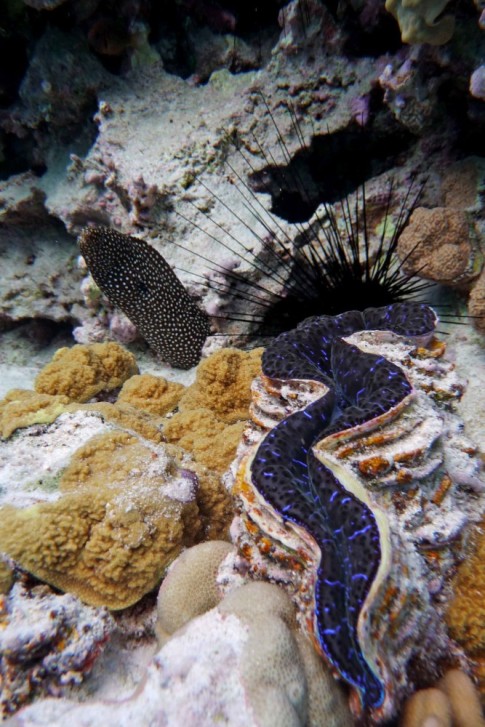 |
A few picks of Roratonga, where we picked up Tomas, and of the incredible Beveridge Reef
20 Photos
Created 1 September 2009
|
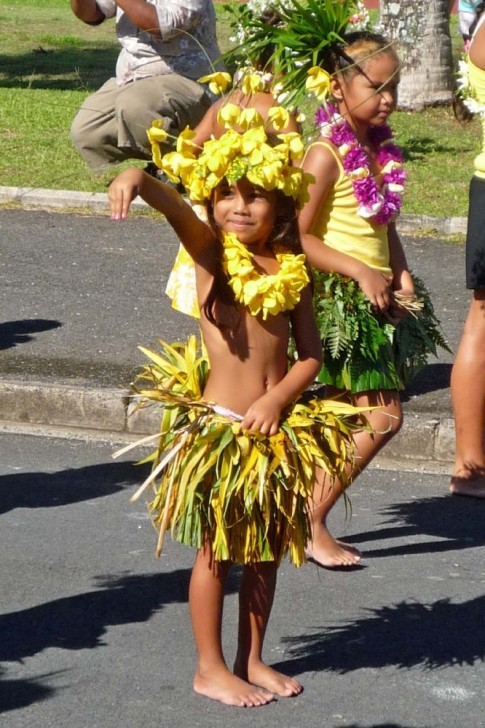 |
Our adventure in the islands of Tahaa and Raiatea in The Society Islands
18 Photos
Created 5 August 2009
|
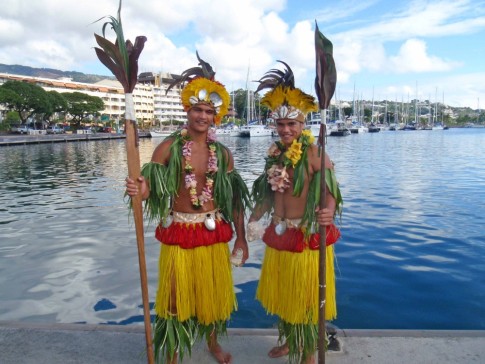 |
The Sailing Rendezvous in Tahiti and Moorea, plus a little of Huahine
35 Photos
Created 5 August 2009
|
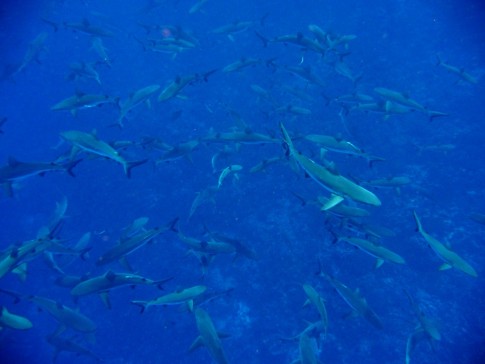 |
Our journey through the coral atolls of the Tuamotus in French Polynesia
65 Photos
Created 19 June 2009
|
S/V Kena
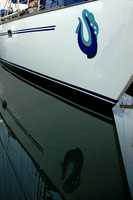
Who: Roger, Sally, Tane, Hunters all
Port: Tutukaka, New Zealand
